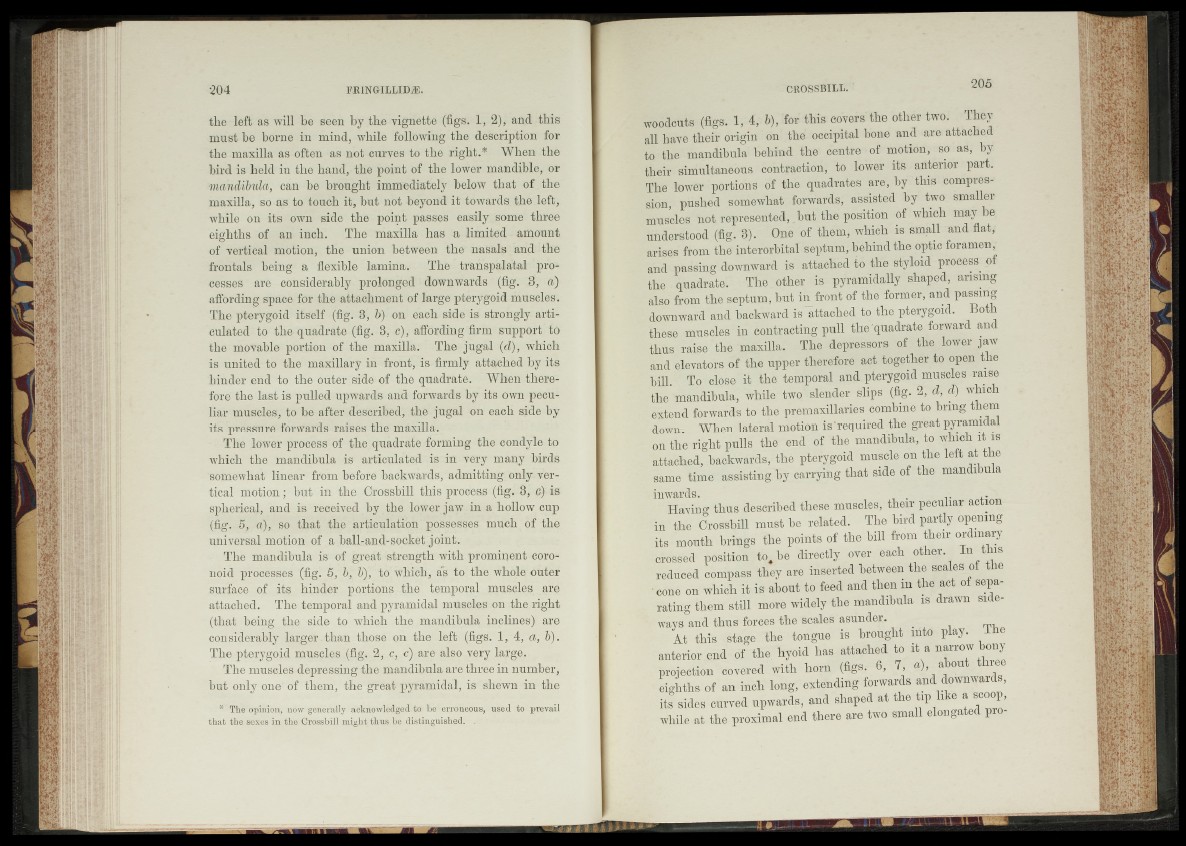
the left as will be seen by the vignette (figs. 1, 2), and this
must be borne in mind, while following the description for
the maxilla as often as not curves to the right.* When the
bird is held in the band, the point of the lower mandible, or
mandibula, can be brought immediately below that of the
maxilla, so as to touch it, but not beyond it towards the left,
while on its own side the point passes easily some three
eighths of an inch. The maxilla has a limited amount
of vertical motion, the union between the nasals and the
frontals being a flexible lamina. The transpalatal processes
are considerably prolonged downwards (fig. 3, a)
affording space for the attachment of large pterygoid muscles.
The pterygoid itself (fig. 3, b) on each side is strongly articulated
to the quadrate (fig. 3, c), affording firm support to
the movable portion of the maxilla. The jugal (d), which
is united to the maxillary in front, is firmly attached by its
binder end to the outer side of the quadrate. When therefore
the last is pulled upwards and forwards by its own peculiar
muscles, to be after described, the jugal on each side by
its pressure forwards raises the maxilla.
The lower process of the quadrate forming the condyle to
which the mandibula is articulated is in very many birds
somewhat linear from before backwards, admitting only vertical
motion; but in the Crossbill this process (fig. 3, c) is
spherical, and is received by the lower jaw in a hollow cup
(fig. 5, a), so that the articulation possesses much of the
universal motion of a ball-and-socket joint.
The mandibula is of great strength with prominent coro-
noid processes (fig. 5, b, U), to which, as to the whole outer
surface of its hinder portions the temporal muscles are
attached. The temporal and pyramidal muscles on the right
(that being the side to which the mandibula inclines) are
considerably larger than those on the left (figs. 1, 4, a, b).
The pterygoid muscles (fig. 2, c, c) are also very large.
The muscles depressing the mandibula are three in number,
but only one of them, the great pyramidal, is shewn in the
* The opinion, now generally acknowledged to be erroneous, used to prevail
that the sexes in the Crossbill might thus be distinguished. .
woodcuts (figs, i f 4, 6), for this covers the other two. They
all have their origin on the occipital hone and are attached
to the mandibula behind the centre of motion, so as, by
their simultaneous contraction, to lower its anterior part.
The lower portions of the quadrates are, by this compression,
pushed somewhat forwards, assisted by two smaller
muscles not represented,.but the position of which may he
understood (fig. 3). One of them, which is small and flat,
arises from the interorbital septum, behind the optic foramen,
and passing downward is attached to the styloid process of
the quadrate. The other is pyramidally shaped, arising
also from the septum, but in front of the former, and passing
downward and backward is attached to the pterygoid. Both
these muscles in contracting pull the quadrate forward an
thus raise the maxilla. The depressors of the lower jaw
and elevators of the upper therefore act together to open the
bill. To close it the temporal and pterygoid muscles raise
the mandibula, while two slender slips (fig. 2, d, d) which
extend forwards to the premaxillaries combine to bring them
down. When lateral motion is'required the great pyramidal
on the right pulls the end of the mandibula, to which it is
attached, backwards, the pterygoid muscle on the left at the
same time assisting by carrying that side of the man i u a
inwards. ,.
Having thus described these muscles, their peculiar action
in the Crossbill must be related. The bird partly opening
its mouth brings the points of the bill from their ordinary
crossed position to# be directly over each ot ei. n _*s
reduced compass they are inserted between the scales of the
- cone on which it is about to feed and then m the act of separating
them still more widely the mandibula is drawn sideways
and thus forces the scales asunder. |
At this stage the tongue is brought into play. e
anterior end of the hyoid has attached to it a narrow bony
projection covered with horn (figs. 6, 7, a), a 011
eighths of an inch long, extending forwards a n d downwards,
its sides curved upwards, and shaped at the tip like a scoop,
while at the proximal end there are two small elongated pro